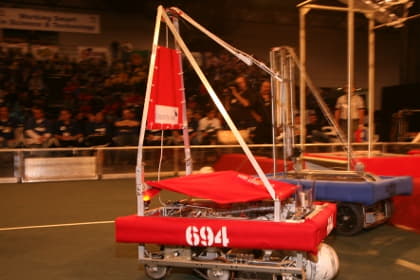2010: Donovan

2010 was, without a doubt, our most successful season. At our first event, the New York City Regional, all the teams were walking around saying that we would be their first pick. We ended up being the first pick of the number 1 alliance captain, 341. We joined forces with 341 and blazed a trail through every alliance in the elimination rounds, winning the New York City Regional for the second time.
For our amazing autonomous mode, which often scored both the balls it picked up, we earned the Rockwell Automation Innovation in Control Award. If that was not enough, we also were an alliance captain at the Connecticut regional and won the most prestigious award in F.I.R.S.T., the Chairman’s award, at the Connecticut Regional making 2010 the first year we qualified 2 times for the championship. Then at the Championship in Atlanta our President of Mechanical Engineering, Seth Berg, was chosen as part of the first group of Dean’s List honorees. He has gone on to be one of many 694 graduates that has studied at MIT. In 2010 the team saw a large influx of newbies who were just as passionate and hard working as the veterans. During the six week Build Season, the team often stayed until 8 PM to work on the bot. The designs for the robot were finished within the first 2 weeks, while team pressed to build the robot in the remaining time. Our six-wheel drive train had a dropped center wheel built to allow easy movement across bumps. Our kicker was inspired by a cam design from an MIT project, and was capable of kicking soccer balls from one end of the field to the other. The team initially decided to ignore the hanging aspect of the game, but a few team members and mentors stubbornly continued building an award-winning hanger. The ability of Donovan to hang at the end of each match scored us many points and contributed greatly to our victory at the New York City Regional.
While the engineers worked hard to design and build the robot, as well as the field, the programmers were also working hard at their end. Before the season began, the senior programmers taught newbies how to use and program in Java, making the change from C++. Then when build season kicked off, everyone was ready to go. New and old programmers worked together to convert old code into Java, as well as generate new code for the autonomous period and the robots camera function. Multiple routines for the autonomous period were developed anticipating many different situations. A combination of rotary encoders, a gyroscope and a camera targeting system was used to auto-align our robot to the goal. Our autonomous period was one of the best at the New York Regional.
Over the course of the year, the marketers also worked hard to spread the word of FIRST. The team hosted many demonstrations in school and also around the city. We attended events such as the World Science Festival, the New York State Fair, and the Tribeca Film Festival, among others, promoting FIRST to spectators attracted by our robots. We also mentored five FRC teams and four FLL teams; many of them went to nationals. We created The Lab, a series of videos about our FIRST experience. Aside from being on YouTube, we also appeared in other media including the CBS early show, NY1, Popular Mechanics, as well as local newspapers and websites.
| Awards |
|
|---|---|
| YouTube Videos | |
| Photo Gallery | |
| Source Code | |
| Additional Resources |